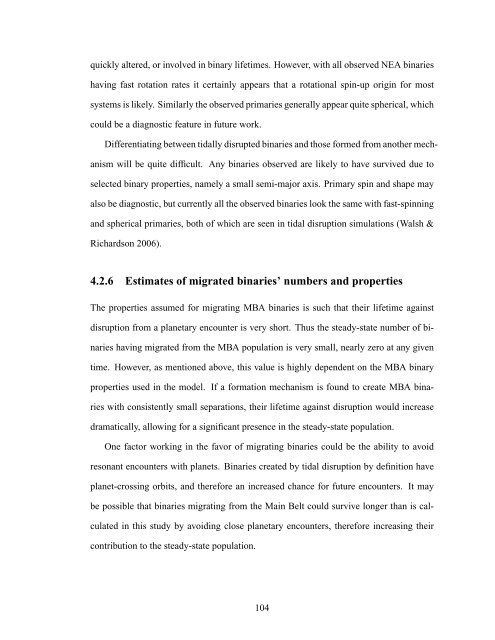Forming Binary Near-Earth Asteroids From Tidal Disruptions
Forming Binary Near-Earth Asteroids From Tidal Disruptions
Forming Binary Near-Earth Asteroids From Tidal Disruptions
Create successful ePaper yourself
Turn your PDF publications into a flip-book with our unique Google optimized e-Paper software.
quickly altered, or involved in binary lifetimes. However, with all observed NEA binarieshaving fast rotation rates it certainly appears that a rotational spin-up origin for mostsystems is likely. Similarly the observed primaries generally appear quite spherical, whichcould be a diagnostic feature in future work.Differentiating between tidally disrupted binaries and those formed from another mechanismwill be quite difficult. Any binaries observed are likely to have survived due toselected binary properties, namely a small semi-major axis. Primary spin and shape mayalso be diagnostic, but currently all the observed binaries look the same with fast-spinningand spherical primaries, both of which are seen in tidal disruption simulations (Walsh &Richardson 2006).4.2.6 Estimates of migrated binaries’ numbers and propertiesThe properties assumed for migrating MBA binaries is such that their lifetime againstdisruption from a planetary encounter is very short. Thus the steady-state number of binarieshaving migrated from the MBA population is very small, nearly zero at any giventime. However, as mentioned above, this value is highly dependent on the MBA binaryproperties used in the model. If a formation mechanism is found to create MBA binarieswith consistently small separations, their lifetime against disruption would increasedramatically, allowing for a significant presence in the steady-state population.One factor working in the favor of migrating binaries could be the ability to avoidresonant encounters with planets. Binaries created by tidal disruption by definition haveplanet-crossing orbits, and therefore an increased chance for future encounters. It maybe possible that binaries migrating from the Main Belt could survive longer than is calculatedin this study by avoiding close planetary encounters, therefore increasing theircontribution to the steady-state population.104












